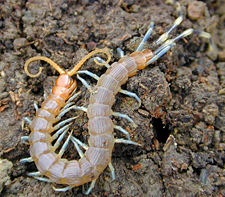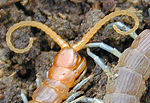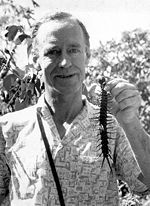Centipede
| Centipedes | ||||||||
|---|---|---|---|---|---|---|---|---|
 | ||||||||
| Scientific classification | ||||||||
| ||||||||
|
Geophilomorpha |
Centipedes (Class Chilopoda) are fast-moving venomous, predatory, terrestrial arthropods that have long bodies and many jointed legs. Chiefly nocturnal, centipedes are found primarily in tropical climates but are also widely distributed in temperate zones. Some species are highly venomous but human deaths are very rare.
Anatomy
Like the millipedes (which, unlike centipedes, are not venomous), centipedes are highly segmented (15 to 173 segments), but with only one pair of walking legs per segment. Centipedes are dorso-ventrally flattened, and are among the fastest and most agile of non-flying arthropod predators.
The head of a centipede has a pair of antennae, jaw-like mandibles, and other mouthparts. The most anterior trunk segment of a centipede has a pair of venomous claws (called maxillipeds) that are used for both defense and for capturing and paralyzing prey. Despite their name, which stems from the Latin words centum (meaning 'hundred') and pes, pedis (meaning 'foot'), they normally have around half that number of legs, though it is possible to find centipedes with over 200 legs.
The house centipede (Scutigera coleoptrata) is a fast-moving carnivore that feeds on insects such as cockroaches, house flies, and other small house pests, and is thus domestically beneficial in nature. Though generally harmless to humans, its alarming appearance and painful bite result in its extermination from residences. The bite of a smaller centipede in temperate areas may be similar to a bee sting, but the bite of a larger tropical species is excruciatingly painful, leaving two black puncture wounds about a centimeter apart.
Size
Scolopendra gigantea, also known as the Amazonian giant centipede, is the largest existent species of centipede in the world, reaching over 30 cm (12 inches) in length. It is known to eat bats, catching them in midflight, as well as rodents and spiders. The prehistoric Euphoberia was the largest known centipede, growing up to one meter (39 in) in length.
There are rumors that state that the Galápagos Islands giant centipede (Scolopendra galapagoensis) can reach sizes of up to 25 inches, although these rumours may result from the rarity of the particular centipede. Captive Galapagos centipedes don't often exceed 8 inches in body length.[1]
The garden centipede, the most common centipede in North America, is a much smaller variety, rarely exceeding a few inches in length.
Most centipedes live in rotting logs or muddy and damp areas.
Breeding
Males spin a small web onto which they deposit a spermatophore for the female to take up, sometimes there is a courtship dance, sometimes the males just leave them for the females to find. In temperate areas egg laying occurs in Spring and Summer but in subtropical and tropical areas there appears to be little seasonality to Centipede breeding.
The Lithobiomorpha, and Scutigeromorpha lay their eggs singly in holes in the soil, the female fills the hole in on the egg and leaves it. The young usually hatch with only 7 pairs of legs and gain the rest in successive moults. Scutigera coleoptera, the American house centipede, hatches with only 4 pairs of legs and in successive moults has 5, 7, 9, 11, 15, 15, 15 and 15 before becoming a sexually mature adult. It takes about 3 years for S. coleoptera to achieve adulthood, however, like millipedes, centipedes are relatively long-lived when compared to their insect cousins, the European Lithobius forficatus can live for 5–6 years.
Females of Geophilomorphapha and Scolopendromorpha show far more parental care, the eggs 15–60 in number are laid in a nest in the soil or in rotten wood, the female stays with the eggs, guarding and licking them to protect them from fungi. The female in some species stays with the young after they have hatched, guarding them until they are ready to leave. If disturbed the females tend to either abandon the eggs or young or to eat them, abandoned eggs tend to fall prey to fungi rapidly, thus breeding is difficult to study in these species.
List of some common species
- Arizona desert centipede
- black centipede
- burrowing centipede
- Chinese red-headed centipede
- common centipede
- common desert centipede
- Egyptian centipede
- feather tail centipede
- garden centipede
- Galápagos centipede
- Giant centipede (Ethmostigmus rubripes)
- giant desert centipede
- giant North American centipede
- giant Sonoran centipede
- house centipede
- Megarian banded centipede
- Peruvian giant orange leg centipede
- red feather tail centipede
- red-headed centipede
- stone centipede
- Sonoran desert centipede
- Tanzanian blue ringed centipede
- Vietnamese centipede
ReferencesISBN links support NWE through referral fees
- Neil A. Campbell, Biology: Fourth Edition, (Benjamin/Cummings Publishing, New York) 1996 page 614 ISBN 0-8053-1957-3
- Cloudsley-Thompson, J.L. (1968). Spiders, Scorpions, Centipedes and Mites, Pergamon Press; Oxford
- E. H. Eason, (1964). Centipedes of the British Isles, Frederick Warne
External links
- Debunking of some centipede myths, by American Tarantula Society
- Tree of Life Project – Chilopoda
- What do you call a centipede?
- Pictures of many centipede species plus information
Credits
New World Encyclopedia writers and editors rewrote and completed the Wikipedia article in accordance with New World Encyclopedia standards. This article abides by terms of the Creative Commons CC-by-sa 3.0 License (CC-by-sa), which may be used and disseminated with proper attribution. Credit is due under the terms of this license that can reference both the New World Encyclopedia contributors and the selfless volunteer contributors of the Wikimedia Foundation. To cite this article click here for a list of acceptable citing formats.The history of earlier contributions by wikipedians is accessible to researchers here:
The history of this article since it was imported to New World Encyclopedia:
Note: Some restrictions may apply to use of individual images which are separately licensed.



